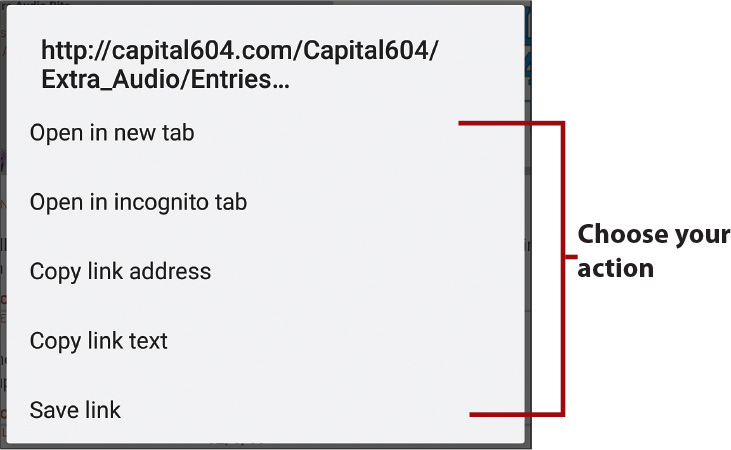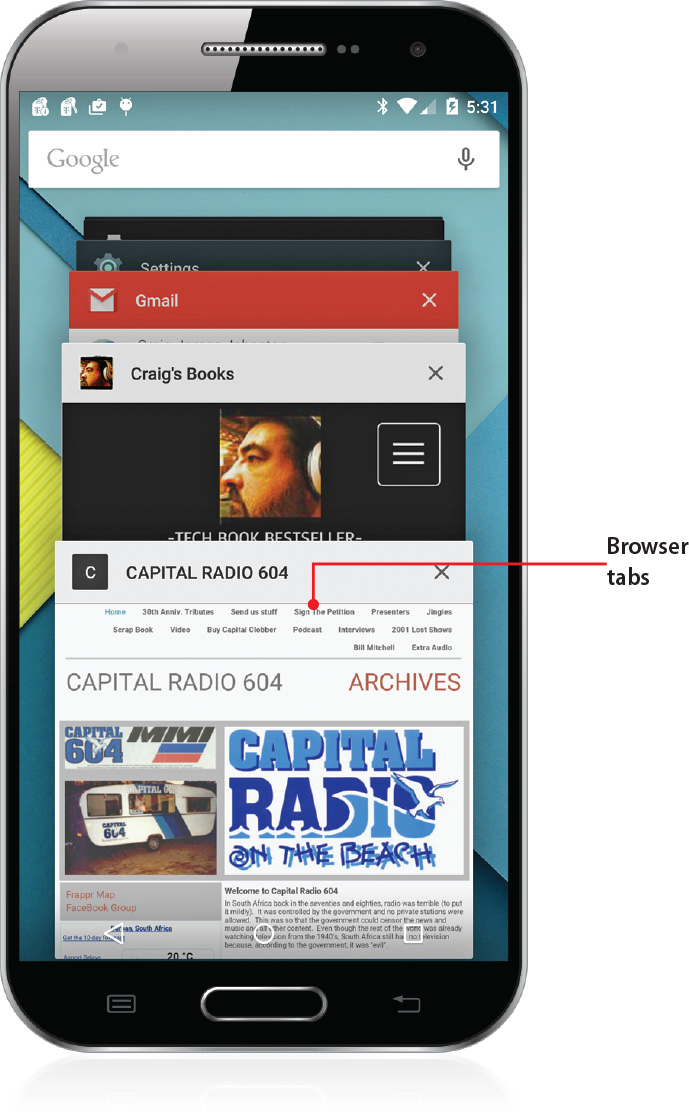6. Browsing the Web with Chrome
In this chapter, you discover how to browse the World Wide Web using the browser capabilities of your Android phone. Topics include the following:
→ Bookmarking websites
→ Sharing websites with your friends
→ Keeping track of sites you have visited
→ Using GPS and browsing together
→ Browsing Incognito
Your Android phone has a fully featured web browser called Chrome. In fact, the experience of using the Android phone’s browser is similar to using a desktop browser, just with a smaller screen. You can bookmark sites, hold your Android phone sideways to fit more onto the screen, and even share your GPS location with websites.
Navigating with Chrome
Let’s dive right in and cover how to run the Chrome web browser and use all its features. You can customize the Chrome browser, share your GPS location, bookmark sites, maintain your browsing history, and even access bookmarks stored on your computer.

2. Tap to type a website address or one or more search terms. Some websites move the web page up to hide the address field. When this happens, you can drag the web page down to reveal the address bar again.
3. Tap the Overview button to see open Chrome browser tabs.
4. Tap to go to the previous page on the current website, or to the previous website you were viewing.
5. Tap the Menu icon to see more options.
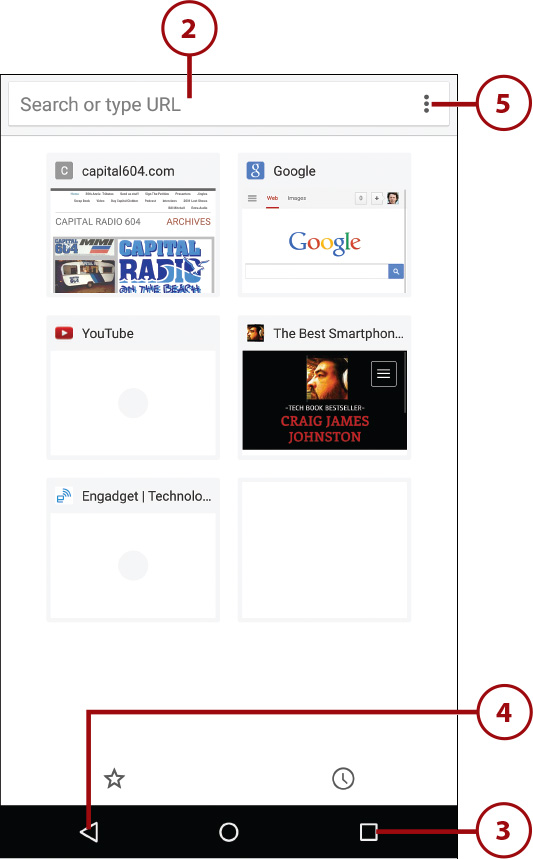
6. Tap to open a new browser tab from which you can go to a new website.
7. Tap to bookmark the website that you are currently looking at. If the site is already bookmarked, you can edit the bookmark.
8. Tap to manually refresh the website.
9. Tap the right arrow to go to the next page on the current website, or to go to the next website, if you had previously tapped the Back button.
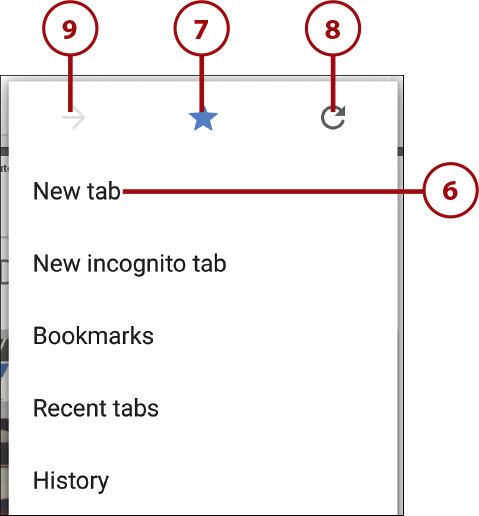
Chrome browser tabs work the same way that your desktop web browser tabs work. If you open a new tab, you can load a different website and then switch between the tabs, effectively switching between multiple open websites. In previous versions of Chrome, you could navigate between tabs using the Chrome interface. In the latest versions of Android and the Chrome browser, the management of Chrome tabs has moved to the Overview screen. When you open a new tab, the Chrome browser opens the new tab for you, and it looks like your previous tab disappears. To navigate between Chrome browser tabs, tap the Overview button. Among the open apps, you will see your browser tabs. You can then tap tabs to switch to them, and close them by swiping or tapping the X in the top right of each tab.

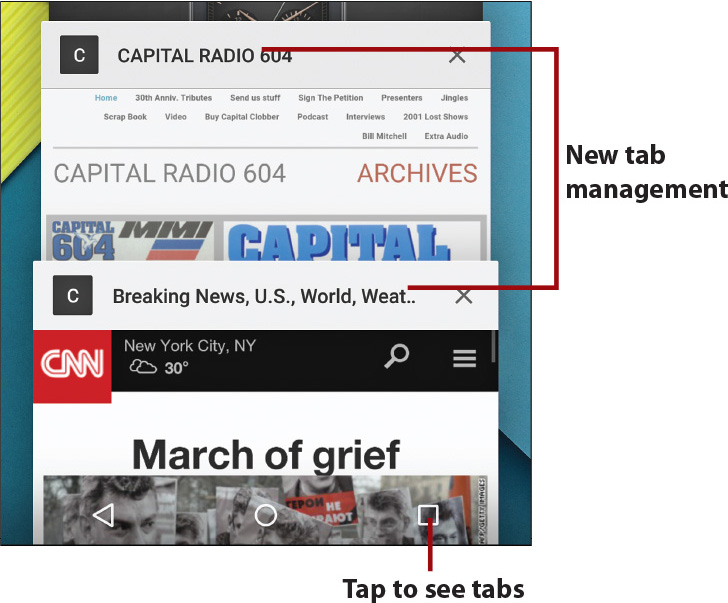
Use Web Page and Chrome Options
While a web page is open, you have a number of options, such as finding text on a web page and forcing Chrome to load the desktop version of a website.
1. Tap the Menu icon.
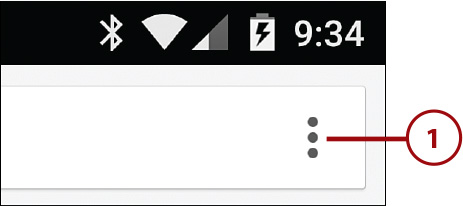
2. Tap to open a new browser tab.
3. Tap to open a new Incognito browser tab.

Browsing in Secret (Going Incognito)
If you want to visit a website in secret, you can. Visiting a website in secret using an Incognito browser tab means that the site you visit does not appear in your browser history or search history and does not otherwise leave a trace of itself on your Android phone. To create a new Incognito browser tab, while in the browser tab screen, tap the Menu icon and then tap New Incognito Tab. One thing to remember is that although all traces of the website you are browsing to in an Incognito tab are not stored on your phone, there are certainly traces of your browsing stored other places, including your Internet service provider (ISP), the website you are visiting, and the routers that your data passes through. To close all open Incognito tabs, but leave regular tabs open, pull down the Notification panel and tap Close All Incognito Tabs.
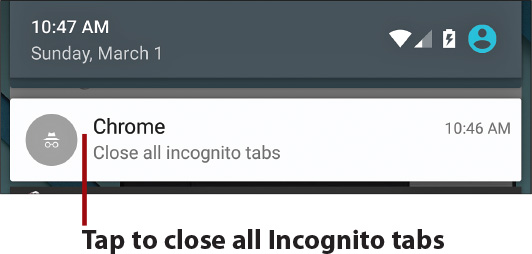
4. Tap to open the Chrome bookmarks screen.
5. Tap Recent Tabs to see websites that were recently opened in Chrome browser tabs on your desktop computer and all other devices where you have the Chrome browser installed and running.
6. Tap to see the history of all websites you have visited on all devices where you run the Chrome web browser. History from Incognito tabs are not visible as they are not stored.
7. Tap to share the current web page’s address using a number of methods, including Facebook, Twitter, Skype, Bluetooth, and Android Beam, or to copy the link to the Clipboard.
8. Tap to print the web page on a printer that is linked to your Google Chrome Cloud Print account, or print the web page to a Portable Document Format (PDF) file.
9. Tap to find a word on the current web page.
10. Tap to add a shortcut for the current web page on your phone’s Home screen.
11. Tap to request the desktop version of the current website if you are seeing a mobile version. When you check the box, Chrome refreshes the page with the desktop version.
12. Tap to change the Chrome web browser settings.

How Can I See My Desktop Computer’s Browser Tabs?
To see your desktop computer’s Chrome browser tabs, make sure you install Chrome on your desktop computer and use it as your default web browser. When setting up Chrome, use the same Google account as you use on your Android phone. Then not only are your bookmarks kept in sync between your phone and desktop (and all other devices where Chrome is installed), but also any browser tabs you have open in Chrome on your desktop computer (called browser windows on the desktop version of Chrome) can be seen as described in step 5. Even if you close Chrome and shut down your computer, you still see the last tabs that were open.
Master Chrome Browser Tricks
Your Android phone has some unique tricks to help you browse regular websites on a small screen.

1. Rotate your Android phone on its side to put the phone into landscape orientation. Your Android phone automatically switches the screen to Landscape mode.

2. Double-tap the screen to zoom in and out.
Zooming with Pinch to Zoom
An alternative way to zoom, which enables you to actually zoom in much further, is to place your thumb and forefinger on the screen and spread them apart to zoom in and then move them back together to zoom out.

3. If menu choices on a web page are too small, when you touch a menu item, the Chrome browser shows you a zoomed-in portion of the menu to enable you to more easily touch your menu item.

Managing Bookmarks and History
Your Android phone enables you to bookmark your favorite websites, but it also keeps track of where you have browsed and can show you your browsing history broken up by days, weeks, and months. The history also enables you to read web pages offline.
Manage Bookmarks
1. Tap the Menu icon (not shown).
2. Tap Bookmarks.
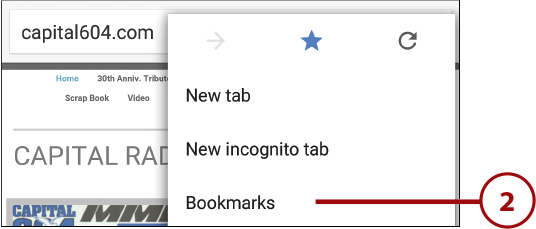
3. Tap to switch between your mobile bookmarks and bookmarks that you have on your desktop computer.
4. Tap a bookmark to open it.

2. Touch and hold a bookmark to see more options.
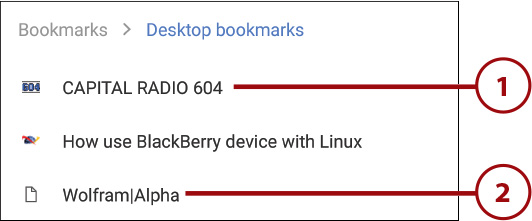
3. Tap to open the bookmark in a new browser tab.
4. Tap to open the bookmark in an Incognito tab (secretive browsing).
5. Tap to edit the bookmark.
6. Tap to delete the bookmark.
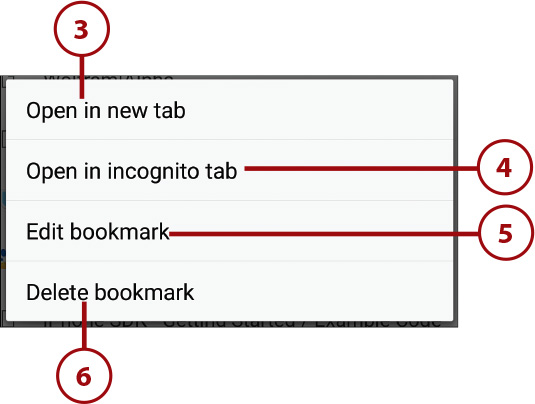
Add a Bookmark
While you are viewing a web page, you can add it to your list of bookmarks.
1. Tap the Menu icon and then tap the Star icon. The Add Bookmark screen displays.

2. Change the bookmark name if you want to. It defaults to the web page’s title.
3. Edit the web page link if you want to or leave it as is (normally best).
4. Select where to save the bookmark. You can choose to save it in Mobile Bookmarks (only on your phone) or in one of the bookmark folders that you have synchronized from your desktop computer.

5. Tap to save the bookmark.

Where Should I Save Bookmarks?
When you save bookmarks, you can choose to save them locally or to one of your desktop bookmark folders. If you choose to save a bookmark locally, it is saved only to your Android phone. The bookmark is not synchronized to the Google Cloud or made available anywhere other than on your phone. If you choose to save the bookmark to one of your desktop bookmark folders, that bookmark is stored in the Google Cloud and is then available to you on any device where you use that same Google account. This includes when you log in to your Google account on your desktop version of the Chrome browser on your computer and any Android smartphone or phone that you purchase and use in the future.
Manage Browsing History
Your browsing history is a list of all websites that you have visited. Browsing your history can help find websites you have visited in the past but forgotten about.
1. Tap the Menu icon (not shown).
2. Tap History.

3. Tap Clear Browsing Data at the bottom of the screen to clear all Chrome browser data, including browser history, cache, cookies, and saved passwords.
4. Tap the X icon to the right of a browser history item to remove it.
5. Touch and hold an item to see more options for that item.


6. Tap to open the website in a new browser tab.
7. Tap to open the website in a new Incognito browser tab.
8. Tap to copy the link for this website to the Clipboard.
9. Tap to copy the link’s title text to the Clipboard.
10. Tap to save the contents of the web page to your phone. Only the text and layout is saved, not the images. You can find the downloaded web page by opening the Downloads app.

Customizing Browser Settings
Your Android phone’s Chrome browser is customizable. This section describes the different settings you can adjust.
1. Tap the Menu icon (not shown).
2. Tap Settings.

3. Tap your Google account.

4. Tap the Google account you want to change on the next screen (if you have more than one account).

5. Tap to enable or disable synchronization, and choose what to synchronize.
6. Check the box to synchronize everything, or uncheck it to selectively choose what to synchronize.
7. Tap to choose whether you want to encrypt saved passwords using your Google credentials, or encrypt everything using a new passphrase.
8. Tap to save your changes and return to the account choice screen.
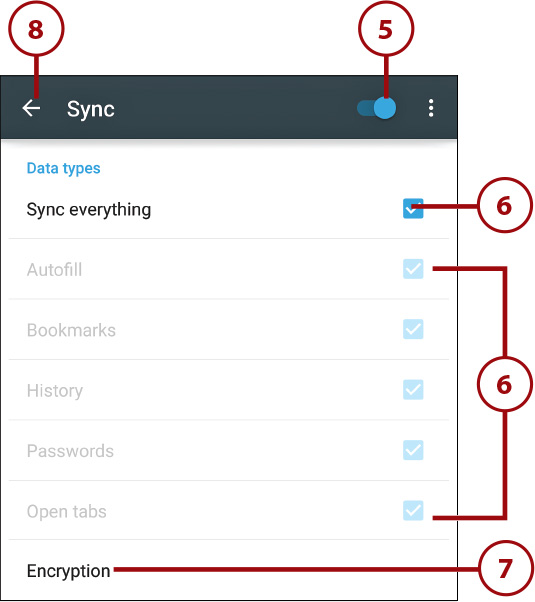
9. Tap to save your changes and return to the main Settings screen.

10. Tap to choose the search engine to use. You can choose Google, Yahoo!, Bing, Ask, or AOL.
11. Tap to change the way that Chrome browser tabs are handled.
12. Tap to enable or disable the Autofill Forms feature and create profiles that contain your information and credit card information for Chrome to use in those forms.
13. Tap to enable or disable the capability for Chrome to save your website passwords. This setting also enables you to view and remove any passwords already stored.
14. Tap to see the Privacy settings. Read more about Chrome privacy settings and what information is sent for each setting, by going to https://support.google.com/chrome/ and searching for privacy settings.

Alternative Handling of Tabs
In step 11, you can turn off the default behavior. The default behavior is where browser tabs are merged with the running apps on the Overview screen; when you turn off the default behavior, the browser tabs are handled inside Chrome. When Chrome is handling its own tabs, a small number appears in a box to indicate the number of open tabs. Tap the number to switch between tabs.

15. Tap to enable or disable Chrome making suggestions of alternatives when you mistype a website address. If enabled, Chrome sends Google what you have typed in the address bar.
16. Tap to enable or disable Chrome making suggestions as you type in the address bar. If enabled, Chrome sends Google what you have typed in the address bar.
17. Tap to enable or disable the feature where Chrome preloads the IP address of every link on a web page to speed up browsing. If enabled, Chrome sends Google the name of the website you are visiting. You can choose to pre-fetch resources on Wi-Fi Only, always (Wi-Fi or cellular data), or never.
18. Tap to enable or disable sending usage and crash reports. If enabled, Chrome might send personal information to Google.
19. Tap to enable the Do Not Track feature. When enabled, Chrome sends a request that you not be tracked to websites you visit. What the website does with that request is unpredictable, so this feature might not be effective.
20. Tap to clear some or all of your browsing data. This includes your browsing history, browser cache, cookies and other site data, any saved passwords, and any autofill info.
21. Tap to save your changes and return to the main Settings screen.

22. Tap to change the size of text displayed on web pages (text scaling) and to override a website’s capability to prevent zooming.
23. Tap to change website content settings such as accepting cookies, blocking pop-up ads, and sharing your location.

24. Tap to enable or disable accepting cookies.
25. Tap to enable or disable allowing websites to access your location and specify how accurately your location is identified. This screen also allows you to manage each website that has asked for your location.

26. Tap to decide whether a website must ask you before it uses your camera and microphone, or if you want to block this access to all websites.
27. Tap to enable or disable the capability for Chrome to run JavaScript. This is normally left on because many websites use JavaScript to enhance their site and make it easier to use.
28. Tap to enable or disable blocking web pop-ups.
29. Tap to enable or disable content protection. Having this enabled allows websites to authenticate your phone so that they can let you watch premium protected videos.
30. Tap to enable or disable Google Translate. When this is enabled, you can translate web pages into other languages.
31. Tap to browse settings for all websites you have visited so that you can clear any data stored by those individual websites.
32. Tap to save your changes and return to the main Settings screen.
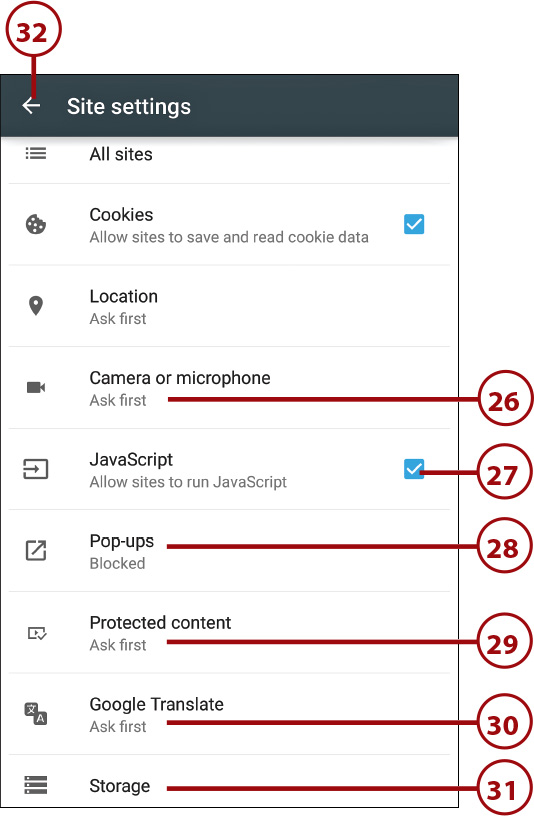
33. Tap Reduce Data Usage to allow Google servers to compress the data coming from websites so that it reduces how much data it takes to load each web page. On some phones this setting may be called Data Saver.
34. Tap to save your changes and return to the Chrome main screen.


When you use text scaling, you instruct your Android phone to always increase or decrease the font sizes used on a web page by a specific percentage. For example, you can automatically make all text 150 percent larger than was originally intended.
What Are Cookies?
Cookies are small files that are placed on your phone by websites. They contain information that might enhance your browsing experience if you return to the website from which they came. For example, they could contain information about what pages you visited before and your browsing history on the website. When you return to the website that placed the cookie, it can read the information in the cookie. Cookies can contain any kind of information, so it is possible for them to be used maliciously, although it’s not likely.
How Does Pop-Up Blocking Work?
When you enable pop-up blocking, your Android phone automatically blocks any website request to pop up a window. This is good because almost every pop-up on a website is some kind of scam to get you to tap a link so that you go to a new site. Sometimes, though, pop-ups are legitimate, and a website that needs you to allow pop-ups will ask you to allow them. You can disable the pop-up blocker any time and then re-enable it when you stop using that website. Unlike desktop computers, you cannot temporarily stop blocking pop-ups, so you need to remember to manually disable and enable the pop-up blocker.
How Does Reduce Data Usage Work?
When you enable Reduce Data Usage, behind the scenes a setting is changed so that every web page you visit (with the exception of secure web pages and web pages opened in an Incognito tab) are rerouted via the Google servers before proceeding to your phone. This is called a proxy, and it means that the Google servers act like a proxy for your web data. Although this feature reduces the size of web pages being downloaded, bear in mind that the way it does this is by compressing images so that they look washed out and end up at a lower resolution.
If you touch and hold a link on a website, you can choose to open it in a new tab, open it in an Incognito tab (secretive browsing), copy the link’s address (to paste into another app, such as an email you are composing), copy the text of the link, and save the link (and its associated web page) as a file on your phone.
